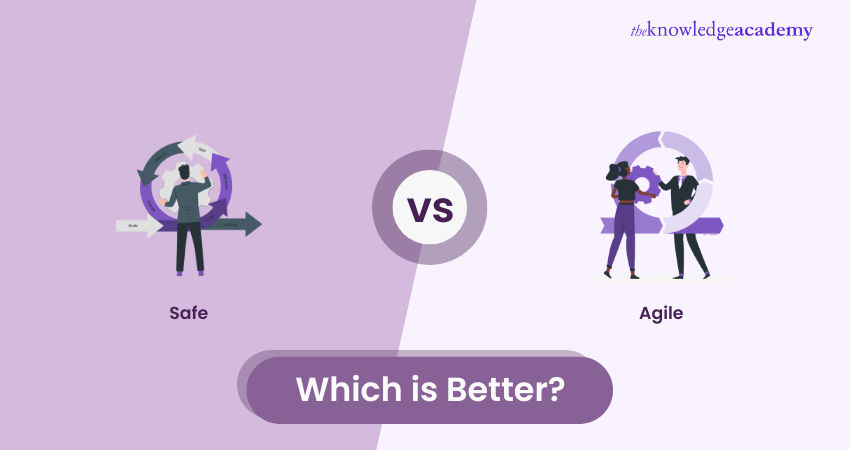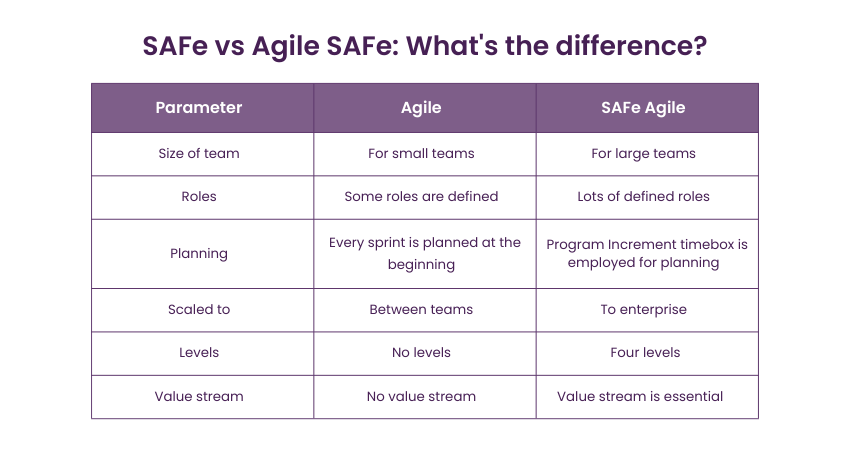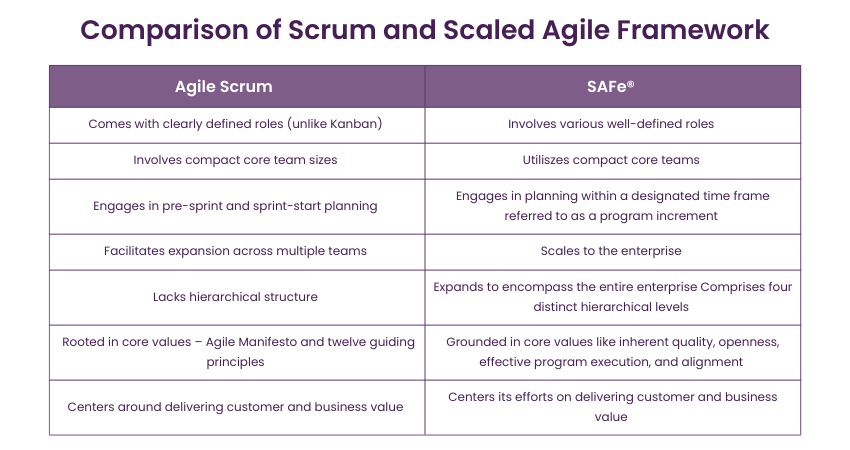We may not have the course you’re looking for. If you enquire or give us a call on 01344203999 and speak to our training experts, we may still be able to help with your training requirements.
Training Outcomes Within Your Budget!
We ensure quality, budget-alignment, and timely delivery by our expert instructors.

SAFe vs Agile debate is like comparing a swift sports car to a powerful semi-truck in Project Management. Agile Methodology is all about speed and flexibility, making it a hit for projects that need to adapt on the fly. But when it comes to the big leagues—those large-scale projects—SAFe enters the ring. It’s Agile amplified, built to manage the complexity of bigger tasks without sacrificing that Agile agility. So, whether you’re zipping around corners with Agile or hauling major cargo with SAFe, you’re equipped to handle the twists and turns of any project.
Delve into this blog that contrasts SAFe vs Agile. SAFe encompasses a suite of management and procedural frameworks designed to apply Agile concepts on a larger enterprise scale. This will provide insights into how these methodologies diverge in their approaches.
Table of Contents
1) What is Agile?
2) What is SAFe (Scaled Agile Framework)?
3) SAFe vs Agile : What's the difference?
4) SAFe vs Agile: What to choose?
5) How does SAFe Agile help in Scaling Agile projects?
6) How are Agile, Scrum, and SAFe similar?
7) Advantages & disadvantages of SAFe Agile
8) Comparison of Scrum and Scaled Agile Framework
9) Conclusion
What is Agile?
Agile is the primary ability to create and respond to change. The set of values and principles associated with Agile is expressed in the Agile manifesto. It helps companies respond to change quickly and adapt to innovation while maintaining maximum quality. Agile was launched as a counter to the traditional approach of Project Management.
Agile helps teams be more cooperative, collaborative, and better organised. The Agile approach divides the project into various phases, with constant collaboration encouraged at every stage. The Agile Manifesto states the four central values of Agile:
1) Individuals and interactions over processes and tools
2) Working software over comprehensive documentation
3) Customer collaboration over contract negotiation
4) Responding to change by following a plan
The idea is that a project can be continuously improved with every stage by implementing change quickly and keeping customer feedback in mind. Various methodologies fall under the general Agile framework:
1) Scrum – Scrum is possibly the most popular type of Agile Methodology. It works on the principle of dividing the project into small phases called Sprints. Only one sprint is worked on at a time, focusing on delivering quality. Each sprint produces a deliverable that is sent for feedback and quickly implemented.
2) Kanban – Kanban literally means “visual signboard”, which is precisely what this methodology is all about. It focuses on using visual aids to manage projects better. The Kanban Board is used to represent the entire project lifecycle. With a proper idea of how the project is going, the teams involved can be well-prepared for the next stage. Projects are more transparent, and teams are better prepared.
3) Extreme Programming (XP) - XP also uses the idea of sprints to make the teams more efficient and productive. As the customer demand varies, the teams are promptly prepared to deal with it and implement it in less time.
4) SAFe – The Scaled Agile Framework or SAFe is used for a project at an enterprise scale. For projects that might need scaling, SAFe provides a light framework to lessen the complexity of scaling while still following a strict Agile approach.
While SAFe vs Agile might seem like a pretty simple concept, there’s a need to dig in a little deeper, as there is still a lot of confusion around the idea.
What is SAFe (Scaled Agile Framework)?
Introduced in 2011, the Scaled Agile Framework facilitates efficient and swift operations within companies, enabling the speedy delivery of products and services to end-users. While rooted in Agile management principles, SAFe enhances processes to address the challenges posed by large teams engaged in complex projects. SAFe management adheres to a core set of principles aimed at enhancing efficiency.
SAFe vs Agile SAFe: What's the difference?
The Agile Manifesto defines the essence of Agile for a small project. Using the Agile Methodology, people can handle scaling between functions or any team. However, once you scale, it is necessary to consider a scalable framework. While SAFe vs Agile is a common ongoing debate, let's try and sort out the confusion by looking at the difference between Agile and SAFe Agile:

SAFe vs Agile: What to choose?
The answer is quite simple. As you assess your project and the required team, you can tell the size it will take. If you’re looking at a smaller team, the best approach is Agile, while if you’re going to work with larger teams, SAFe can help keep everything simple while maintaining quality.
The vital thing to keep in mind is that the approach you take also depends on the budget for the project. Smaller teams mean fewer roles, while larger teams will need more roles assigned explicitly to several people. SAFe sometimes requires the employment of more people to ensure that all processes run smoothly. With Agile approaches like Scrum or Kanban, some roles can be shared by the same member. This reduces the cost of the project significantly.
The budget for the project is also an important consideration when choosing between the two. The difference between Agile and SAFe Agile is majorly based on the resources involved. A larger project will have a larger budget (though this might not always be the case), so it’s possible to employ more roles and keep the process more streamlined. This is the perfect path for SAFe. However, Agile can help reduce the budget significantly in terms of roles unless your team size is large.
How does SAFe Agile help in Scaling Agile projects?
Scaled Agile Framework, as the name suggests, provides a scaled framework for Agile processes. While Agile is a pretty apt methodology for small-scale projects, SAFe delivers the same value and quality for enterprise-scale projects. SAFe takes the concept of Agile and applies it on a much grander scale. Therefore,
As we’ve discussed earlier, SAFe goes beyond the Agile principles. It includes Lean and DevOps along with Agile to help companies become more flexible. It can be achieved on four different levels, namely:
1) Essential SAFe – An Agile Release Team (ART) delivers constant solutions using minimum events and roles.
2) Large Solution SAFe – It works with added practices and roles that help deliver possibly the most significant applications and systems. Enterprise Solution Delivery is employed to make the projects more competent.
3) Portfolio SAFe – Multiple value streams are implemented to execute and organise solution development.
4) Full SAFe – Full SAFe employs hundreds of people to develop and maintain solutions.
Unlock the power of Lean Portfolio Management with our SAFe® Training – join us now!
How are Agile, Scrum and SAFe® similar?
Agile Methodologies, including Scrum, XP, and Kanban, share common characteristics, such as working in short cycles and maintaining close collaboration with customers. However, when comparing Agile with SAFe, the focus shifts towards Scrum and SAFe®.
Both Scrum/Agile and SAFe employ roles like Product Owner, Scrum Master, and Teams, and they adhere to practices like sprints, sprint reviews, and retrospectives. Agile Methodologies' advantages encompasses the following:
a) Enhanced customer satisfaction through consistent involvement
b) Swiftly adjusting courses from less effective solutions
c) Decreased risks due to shorter development cycles
d) Ingrained quality practices,
e) New opportunity for ongoing improvement through regular retrospectives
In the case of SAFe®, it not only encompasses these Agile benefits but also introduces a broader perspective. It emphasises viewing work regarding value streams while considering the enterprise's strategic portfolio. This more comprehensive approach allows for alignment with the overall business strategy and a more holistic understanding of the organization's goals and objectives.
4 core values of SAFe:
Agile Project Management promotes enhancing management practices to optimise processes and boost team member performance. This methodology is built on four fundamental values that Agile practitioners uphold for optimal results:
1) Prioritising Individuals and Interactions Above Processes and Tools: In Agile, the focus shifts from rigid regulations to the contributions of individuals and teams. Agile teams foster open communication, frequent engagement, and effective collaboration to deliver the best customer outcomes. This approach extends to management, which actively participates in the process to facilitate team improvement rather than just observing.
2) Emphasising Working Software Over Extensive Documentation: The ultimate aim is customer satisfaction, driving teams to concentrate on developing and delivering top-notch products. While documenting the process is essential, solving the problem and creating a high-quality solution take precedence.
3) Valuing Customer Collaboration Over Contractual Negotiations: Agile places greater importance on customer contentment than strict contractual terms. The primary objective is to meet customer needs, which involves granting them a significant role in designing the product. Customers actively engage in the process, providing essential input to shape products that align with their requirements.
4) Prioritising Adaptation to Change Over Adherence to a Plan: While veering from a predetermined plan might seem risky, Agile views change as an avenue for improvement. Unlike the notion that straying from a project leads to failure, Agile welcomes change as an opportunity. It proves proficient in incorporating modifications, as it embraces them and favours them over strictly adhering to initial plans.
Advantages & disadvantages of SAFe Agile
SAFe Agile offers streamlined coordination but has some specific limitations. Here, we will explore their advantages and disadvantages in detail:
Advantages of SAFe Agile
a) Scalability: SAFe Agile scales Agile practices to the enterprise level, fostering collaboration among teams and breaking down silos for cohesive product delivery.
b) Business goal alignment: SAFe Agile ensures alignment with organisational strategies by managing investments, prioritising work, and governing development processes.
c) Enhanced efficiency: SAFe Agile handles complex projects effectively, prioritising work based on economic value through Value Stream focus.
d) Defined management roles: SAFe Agile establishes management roles overseeing financial, technical, and business aspects, ensuring development team involvement and top management oversight in large-scale projects.
Disadvantages of SAFe Agile
a) Reduced autonomy: SAFe Agile's emphasis on centralised decision-making can diminish the autonomy of development teams, resulting in reduced ownership and engagement, potentially impacting product quality.
b) Complex planning: SAFe Agile's extensive focus on the 'big picture' leads to longer and more intricate planning and development cycles, causing delays in product delivery, particularly in agile environments.
c) Administrative overhead: SAFe Agile's administrative layers overseeing multiple teams and projects introduce additional overhead, resulting in delays and slower feedback loops during development.
d) Limited flexibility: SAFe Agile's design for large-scale projects makes changes more challenging due to administrative layers and value stream focus, causing delays in responding to customer feedback and market changes.
Comparison of Scrum and Scaled Agile Framework
Here, we have listed a detailed comparison of the Scrum and Scale Agile Framework:

Scrum is deeply rooted in Agile principles, emphasising iterative development and self-organising teams. On the other hand, SAFe builds upon Agile principles but expands to include additional principles tailored for scaling Agile across the enterprise.
Salary
When considering salary, roles within Scrum and SAFe can have differing compensation levels. Scrum roles salary depends on location, experience, and industry standards. Conversely, SAFe roles often command higher salaries due to the complexity of managing large-scale Agile implementations.
Advantages
The Advantages of Scrum lie in its promotion of teamwork, customer collaboration, and iterative delivery of products. SAFe, on the other hand, provides a structured framework for scaling Agile practices across the organisation.
Values
Values within Scrum revolve around commitment, courage, focus, openness, and respect. In contrast, SAFe values alignment, built-in quality, transparency, program execution, and organisational agility.
Roles
The main roles associated with Scrum Agile Methodology are as follows:
1) Team Lead/ Scrum Master – Forms the team, manages resources, and deals with the problems.
2) Team member – Creates and delivers all the products.
3) Product Owner – The stakeholder that creates the work list and provides information.
4) Architecture Owner – Makes all the architectural related decisions.
In SAFe, the traditional roles associated with Agile are incorporated along with some added ones to help enterprises scale:
1) Integrator – In bigger projects, there are various subsystems that need to be integrated to create a whole system. For this job, one or more integrators need to be brought in.
2) Independent Tester – Responsible for testing work as it is happening. Needed for complex projects.
3) Product Manager – Make sure that the features are better understood.
4) Release Train Engineer – Ensure the ART works collaboratively.
5) Solution Architect/ Engineer – Design the architecture for ARTs so the solutions are appropriate.
6) Solution Train Engineer – Guides the ARTs in the value stream.
7) Epic Owner – Defines an epic, its benefits, and its implementation.
Conclusion
Agile has been developed over time to the framework that provides business agility, allowing organisations remain flexible in getting approaches for getting all the work done. While SAFe is great for larger projects that need something that goes beyond the Agile roles.
Learn the intricacies of implementing Agile by joining our Agile Project Management Foundation & Practitioner (AgilePM®) Training.
Frequently Asked Questions

SAFe facilitates the synchronisation of alignment, collaboration, and delivery across numerous agile teams. It extends Scrum and Kanban to the enterprise level, integrating Portfolio Management, Program Management, and team-level operations.

For instance, a rapidly expanding engineering company with numerous departments and projects might opt for the Large Solution SAFe framework to coordinate and synchronise its teams and initiatives, guaranteeing efficient, effective, and timely delivery of work.

The Knowledge Academy takes global learning to new heights, offering over 30,000 online courses across 490+ locations in 220 countries. This expansive reach ensures accessibility and convenience for learners worldwide.
Alongside our diverse Online Course Catalogue, encompassing 17 major categories, we go the extra mile by providing a plethora of free educational Online Resources like News updates, Blogs, videos, webinars, and interview questions. Tailoring learning experiences further, professionals can maximise value with customisable Course Bundles of TKA.

The Knowledge Academy's Knowledge Pass, a prepaid voucher, adds another layer of flexibility, allowing course bookings over a 12-month period. Join us on a journey where education knows no bounds.

The Knowledge Academy offers various Agile Trainings, including the Agile Project Management Foundation & Practitioner (AgilePM) Course, Agile Project Management Foundation (AgilePM) Course, and Lean Portfolio Management SAFe Course. These courses cater to different skill levels, providing comprehensive insights into the Agile Release Train.
Our Project Management Blogs cover a range of topics related to SAFe Agile, offering valuable resources, best practices, and industry insights. Whether you are a beginner or looking to advance your Project Management skills, The Knowledge Academy's diverse courses and informative blogs have got you covered.
Upcoming Project Management Resources Batches & Dates
Date
 Agile Project Management Foundation & Practitioner (AgilePM®)
Agile Project Management Foundation & Practitioner (AgilePM®)
Mon 6th Jan 2025
Mon 13th Jan 2025
Sat 18th Jan 2025, Sun 19th Jan 2025
Mon 20th Jan 2025
Mon 27th Jan 2025
Mon 3rd Feb 2025
Mon 10th Feb 2025
Mon 17th Feb 2025
Mon 24th Feb 2025
Mon 3rd Mar 2025
Mon 10th Mar 2025
Mon 17th Mar 2025
Sat 22nd Mar 2025, Sun 23rd Mar 2025
Mon 24th Mar 2025
Mon 31st Mar 2025
Mon 7th Apr 2025
Mon 14th Apr 2025
Tue 22nd Apr 2025
Mon 28th Apr 2025
Tue 6th May 2025
Mon 12th May 2025
Sat 17th May 2025, Sun 18th May 2025
Mon 19th May 2025
Tue 27th May 2025
Mon 2nd Jun 2025
Mon 9th Jun 2025
Mon 16th Jun 2025
Mon 23rd Jun 2025
Mon 30th Jun 2025
Mon 7th Jul 2025
Mon 14th Jul 2025
Sat 19th Jul 2025, Sun 20th Jul 2025
Mon 21st Jul 2025
Mon 28th Jul 2025
Mon 4th Aug 2025
Mon 11th Aug 2025
Mon 18th Aug 2025
Mon 25th Aug 2025
Mon 1st Sep 2025
Mon 8th Sep 2025
Mon 15th Sep 2025
Sat 20th Sep 2025, Sun 21st Sep 2025
Mon 22nd Sep 2025
Mon 29th Sep 2025
Mon 6th Oct 2025
Mon 13th Oct 2025
Mon 20th Oct 2025
Mon 27th Oct 2025
Mon 3rd Nov 2025
Mon 10th Nov 2025
Sat 15th Nov 2025, Sun 16th Nov 2025
Mon 17th Nov 2025
Mon 24th Nov 2025
Mon 1st Dec 2025
Mon 8th Dec 2025
Mon 15th Dec 2025







 Top Rated Course
Top Rated Course



 If you wish to make any changes to your course, please
If you wish to make any changes to your course, please


